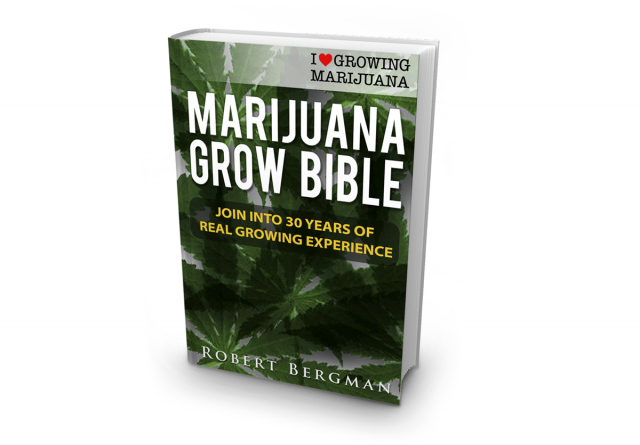 For all the promise of a title like Marijuana Grow Bible, the e-book itself is oddly… brief. While the word “bible” evokes all the authority and breadth of a treatise, this text (from the editor of ilovegrowingmarijuana.com) functions more like an introductory pamphlet.
For all the promise of a title like Marijuana Grow Bible, the e-book itself is oddly… brief. While the word “bible” evokes all the authority and breadth of a treatise, this text (from the editor of ilovegrowingmarijuana.com) functions more like an introductory pamphlet.
Some of the information in this freely downloadable e-book is useful. Other tidbits are demonstrably false. And some of the book’s advice, if followed uncritically, could lead to disaster. The work is a perfect, object example of the principle that ‘what you get for free costs too much’. Take the discussion on indoor lighting, for example… here is an area, as any experienced indoor grower can attest, where novices can mess up badly; but, author Robert Bergman traverses through this nuanced ground with the delicacy of a steamroller. Early on, he insists that high-intensity lights like Metal Halide (MH) and High Pressure Sodium (HPS) are “without question, the best for your marijuana garden.” Fair enough — there are plenty of experienced indoor growers who would, in general, agree with that statement. But when Bergman discusses lighting in the early stages of a plants development, he devolves into potentially disastrous ambiguity. Although he cautions that only fluorescent and other low-heat bulbs may be safely used in close proximity to seedlings in the germination stage, he appears to forget this important caveat later on when discussing light proximity in the early vegetative stages: declaring that “the instructions on the lights might tell you to keep them a certain distance from the plants, but cannabis requires a lot of energy to thrive.” Bergman urges growers to disregard such warnings and place lights 2-4 inches away from young plants if they’re “low-output,” and 4-6 inches away for lights which are “high-output.” Experienced growers will assume he means fluorescent bulbs, as only they could be safely used so close to plants this early in their development. But novice growers, for whom the e-book seems intended, may read too much into Bergman’s blanket statement on the superiority of HIDs and burn their entire crop to a crisp within minutes.
To be fair, other discussions will be far more useful to the novice grower: in particular, the book’s discussions on seed selection, watering and pest control, which all provide a decent overview. But, somewhat bizarrely for a book which claims to be the Bible of its subject, its indoor growing section mentions not a single word about hydroponics — the most popular method employed by today’s indoor growers. It’s understandable for a brief overview like the Marijuana Grow Bible to avoid trying to explain all the nuanced ins and outs of hydroponic, aquaponic or aeroponic techniques, which are arguably best left to advanced cultivators. But to act as if soil were the only indoor option does the reader a disservice.
In contrast to the muddled coverage of the indoor cultivation section, the book’s section on outdoor growing is downright offensive: Bergman actually has the gall to recommend “guerrilla farming” to his readers who don’t own their own secluded land. After devoting exactly three sentences to the “obvious dangers” of the technique — which in his mind all come down to risk of arrest — Bergman goes on to advocate the use of this extremely destructive technique. Apparently neither the destruction of natural ecosystems, nor the erosion of hard-won political will from local communities outraged by growing on public lands, seem to bother this author one bit.
But while bad enough in itself, the blatant advocacy of guerrilla growing represents the much bigger flaw of the Marijuana Grow Bible — the fact that, philosophically, the book has completely missed the zeitgeist. Bergman, having apparently grown up with the work of far more authoritative authors like Ed Rosenthal (whom he shamelessly rips off, through a paraphrase of one of Ed’s trademark witticisms, on the very first page), entirely lacks the imagination to visualize a useful cultivation guide beyond the paradigm in which Rosenthal rose to fame — namely, the drug war. If he were to check his watch, he would no doubt notice that the year is 2014 — and that the big story in cannabis cultivation today may be found in legal, regulated markets, where absurdities like guerrilla grows on public lands and covert closet ops are relegated to their proper places, as footnotes in history. Ed Rosenthal, in fact, knows this better than anyone — his newest book is titled, not coincidentally, Beyond Buds.
What is needed, instead of all of this spurious drug war foolishness, is a grow bible which can look ahead — to teach growers how to adapt to a rapidly changing market. A truly useful book on the subject would break growers out of the Rosenthal paradigm — with its signature insistence on producing high quality cannabis in covert spaces — to prepare them for the future already just around the corner: a market where no one has to hide, but the stakes in fact will be higher than ever. A book which teaches today’s closet and backwoods growers how to compete with the likes of RJ Reynolds and GW Pharmaceuticals — now that would be worthy of the title “bible.”









